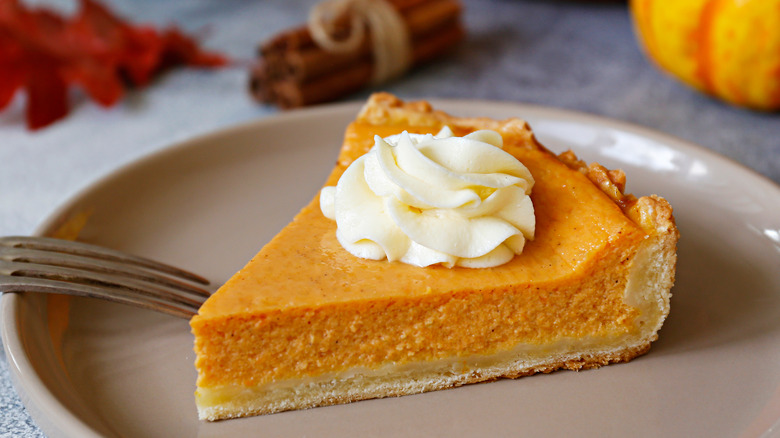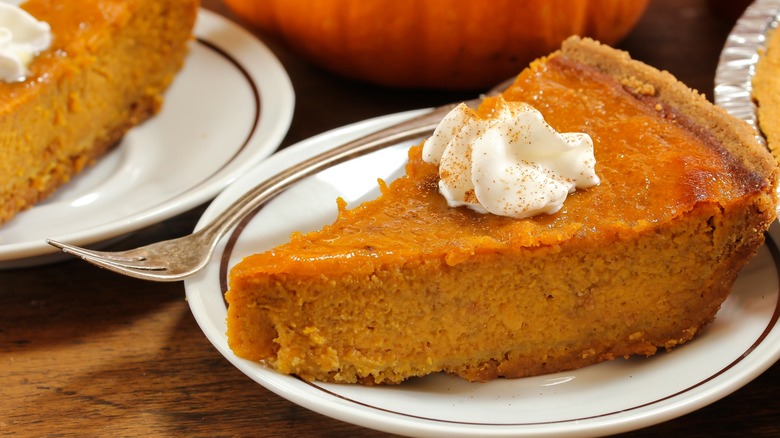The Pumpkin Pie Hack That Saves You The Hassle Of Making Separate Crust
For bakers who fear the soggy bottom or dread the burnt edges, ditching a separate crust for that pumpkin pie seems like a perfect solution. It is time to batter up a pumpkin pie hack that captures a crust-like moment but is much easier to master.
To be clear, this baking tip is not just pumpkin pie filling poured into a pie plate and baked. While that scenario can work, the consistency is not the same as a creamy custard-like center with a separate crust-like edge. For some people, the best part of a pie is the contrast between the two components.
Instead of blind baking a pastry crust, this pumpkin pie hack pours a cake-like batter into the base of the pie dish. After it settles, the filling is slowly poured into the center and the remaining cake-like batter is folded around the edges. As the pie bakes, the base surrounds the pumpkin custard, creating a crust. Since both components bake simultaneously, there is consistency in the process that helps reduce execution errors.
If a home baker loves pumpkin pie, but fears a poorly executed crust, this self-crusting pumpkin pie hack can be the solution. It will impress guests more than just buying that Costco dessert.
Does pumpkin pie really need a crust?
While expert bakers seem to make quick work of that delicate, flaky pie dough, others might prefer to roll out a pre-made crust. Both scenarios do have an element of failure that can happen as the dough bakes. With a pumpkin pie, does that seasonal favorite really need a pie crust?
One tweak to the pumpkin pie ingredient list can create a self-crusting pie. By adding ½ cup flour or Bisquik, the filling creates an edge as it bakes in the pie dish. Although recipes vary, that addition changes the consistency and adds a firmer texture to the pumpkin dessert. That starch acts like a thickener to the liquid ingredients. Some people might feel this baking hack is less pie-like and slightly more cakey or bready, but it does simplify the process.
To be clear, this concept does not create a traditional crust or separation between layers. The entire bite has the same consistency. But for bakers who prefer to stay away from the rolling, blind baking, and other dough conundrums, a pour-and-bake scenario might be the hack that earns their dessert a blue ribbon in simplicity.
Want a simple pumpkin pie crust? Use graham crackers
While a self-crusting pumpkin pie or a crustless pumpkin pie might simplify the baking process and reduce potential baking pitfalls, a graham cracker crust can be the easiest pie crust to master. By simply combining crushed graham crackers, butter, and sugar, the mixture bakes quickly with little error. Once that golden crust sets, the luscious pumpkin pie filling tops the crunchy, crumbly bottom before it heads back into the oven. The resulting dessert offers the contrasting textures with less worry about over, under, or burning the pie crust.
Even though making a graham cracker crust from scratch is relatively easy, the baking aisle has pre-made options readily available. The home baker just has to make the filling. The semi-homemade option could be the first step to building that baking confidence.
One of the reasons why the graham cracker crust can be more appealing than a self-crusting or no-crust pumpkin pie is the textural contrast. Given that pumpkin pie is creamy, that little crunch can create more eating satisfaction bite after bite. It might not necessarily be grandma's flaky pie dough, but it does make the dessert feel like a pie, not a one-note custard.


